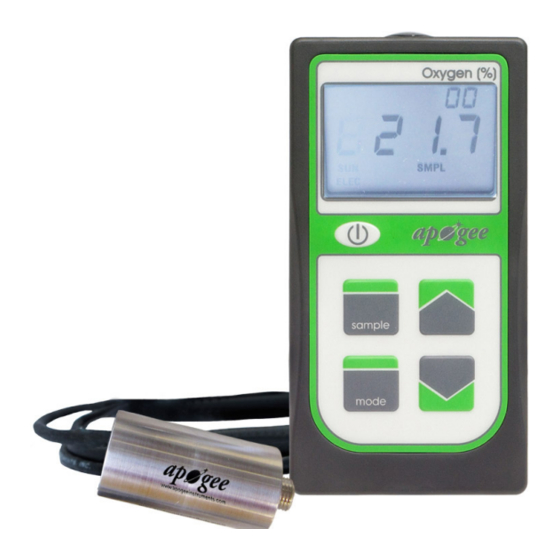
Table of Contents
Advertisement
Quick Links
Humidity Changes
The graph below shows an example of humidity dependency.
The sensor chemistry is not influenced by humidity, but its
output decreases because O
molecules in the air. The effect of humidity is larger at warmer
temperatures because there is more water vapor in the air. To
eliminate humidity effects, simply recalibrate.
For use in high humidity, such as soil, remove
the head and take the calibration measurement
over water in a sealed container as shown at
right.
is displaced by water vapor
2
3
Oxygen Meter
This sensor is a galvanic cell-type oxygen sensor that
measures oxygen gas (O
) in air. It has a lead anode, a gold
2
cathode, an acid electrolyte, and a fluorine resin membrane.
The current flow between the electrodes is proportional to
the oxygen concentration being measure. An internal bridge
resistor is used to provide an mV output linearly proportional
to O
. Unlike polargraphic oxygen sensors, galvanic cells do not
2
require a power supply. The hand-held meter used to measure
the sensor uses a 3 V coin cell battery.
The mV output responds to the partial pressure of oxygen in
air. The standard units for partial pressure are kPa. However,
gas sensors that respond to partial pressures are typically
calibrated to read out in mole fraction of the gas in air, or units
of moles of oxygen per mole of air. These units can be directly
converted to % O
in air, or ppm O
2
of oxygen in our atmosphere is 20.95%, and this precise
percentage has not changed for decades. It is also constant
across changing temperatures or pressures. This allows for
precise calibration of the instrument.
Being a galvanic cell type sensor, a small amount of oxygen
is consumed in the reaction in order to produce the current
flow and subsequent mV output. The oxygen consumption
was measured to be 2.2 µmol O
concentration was 20.95% (3240 mmol) at 23 C.
Effects on Output
For the most reliable measurements, the O
to be used in a vertical position, as shown. A flow-through or
diffusion head is not required for making measurements.
Influences from Various Gases
The sensor is unaffected by CO, CO
CH
. There is a small effect (approximately 1%) from NH
4
and C
H
(benzene). The sensor is sensitive to SO
6
6
damaged by O
.
3
in air. The concentration
2
per day when the O
2
2
2
sensor is designed
2
, NO, NO
, H
S, H
, and
2
2
2
2
, HCI,
3
and can be
2
4
Advertisement
Table of Contents

Summary of Contents for Apogee MO-200 Series
- Page 1 Oxygen Meter This sensor is a galvanic cell-type oxygen sensor that measures oxygen gas (O ) in air. It has a lead anode, a gold cathode, an acid electrolyte, and a fluorine resin membrane. The current flow between the electrodes is proportional to the oxygen concentration being measure.
- Page 2 Using the Meter Temperature Sensitivity 1) Press the power button to start. The meter A change in temperature changes the amount of O available will turn itself off two minutes after button is to the sensor and therefore changes the mV output that pushed to conserve battery.
- Page 3 The life expectancy of the sensor is expressed in %-follows: [Oxygen Concentration (%) x Exposure Time (hours)] Accordingly, the life of an Apogee oxygen sensor is 900,000 hours or approximately 5 years of continuous use at 20.95% oxygen at 20 C.
















Need help?
Do you have a question about the MO-200 Series and is the answer not in the manual?
Questions and answers